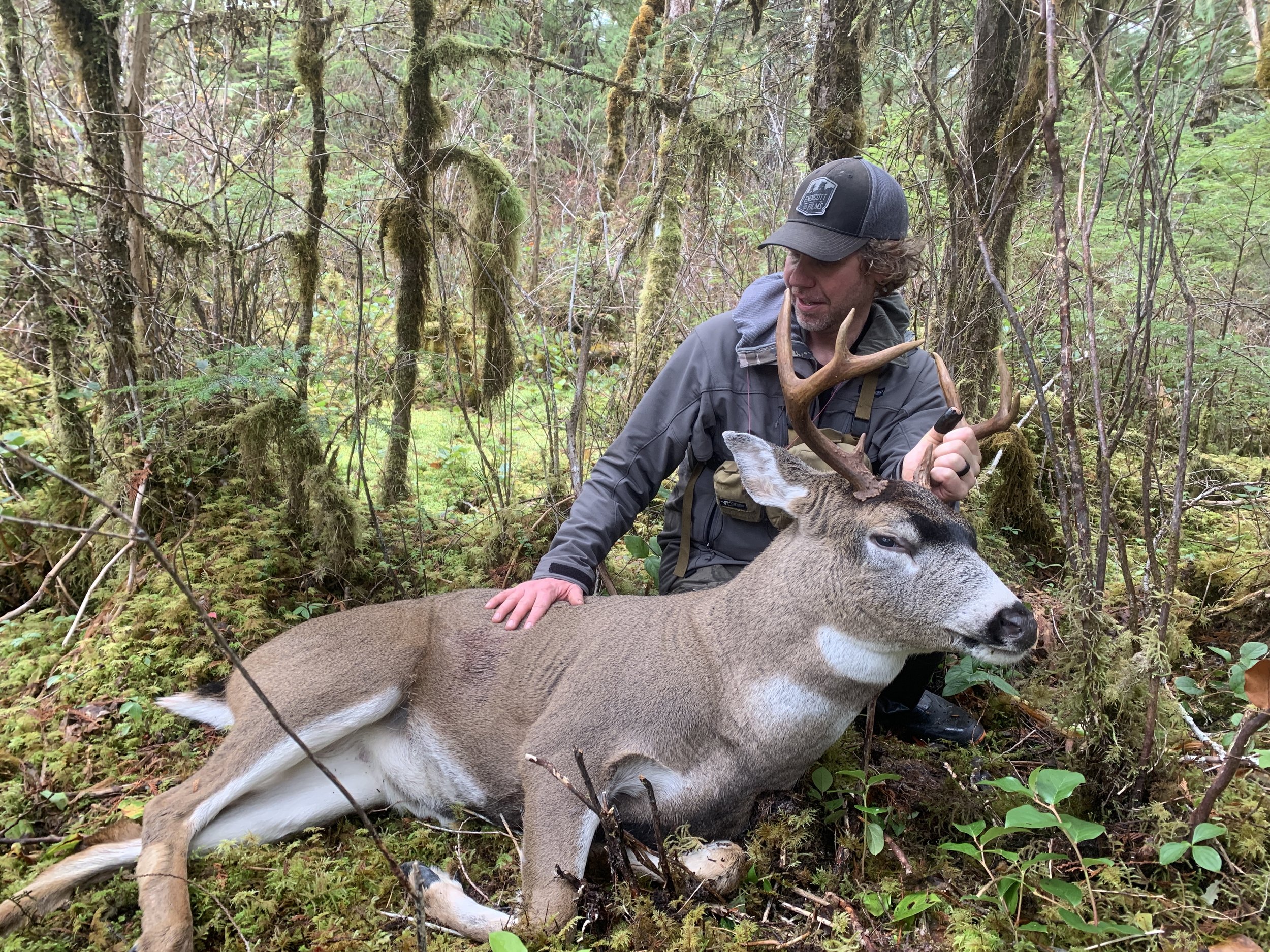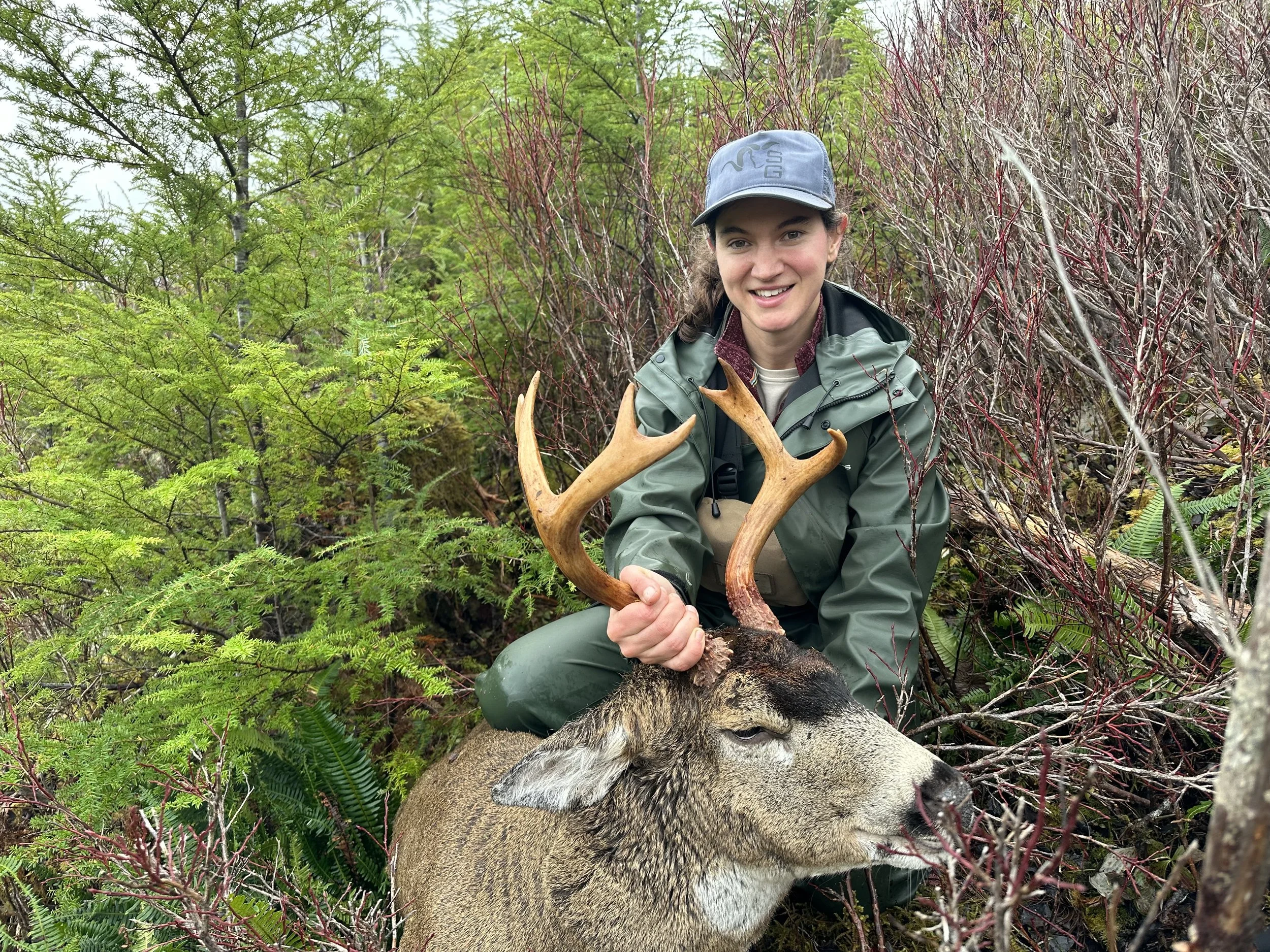Gear Review - Stone Glacier M7 pant
How my Stone Glacier M7 pants have handled Alaska, told through hunting stories during rut
Rain pants have disappointed me all my life.
I grew up in Klawock, Alaska, and figured that no matter what I wore, I would get soaked, so I learned early on to value comfort and warmth above all else.
As I got older, I tried to spend the money and realized that what people mean by “buy once, cry once” means they paid too much money for something that didn’t really work. Fancy tech upcharge, fancy brand upcharge, pay for the celebrity spokesperson upcharge. Cry when it doesn’t live up to the hype. There is no crying when you buy something that works, even if it is expensive. There is joy.
However, failure is an inevitability. The best we can expect is gear that can function in most situations and last for a long time. Alaska is brutal on gear in a way that can’t be replicated. I live in Ketchikan where it rains up to 160 inches a year and an average of 18 inches in October alone (that’s what Bozeman gets in a year). It’s not just about the rain, it’s that hunting necessitates movement through dense vegetation which forces water through even the most sophisticated technology. This is why most Alaskans don’t trust anything that claims to be “breathable.” So I keep buying pants under the assumption that within a year they will have reached their threshold. They’ll probably be fine in a downpour (singular) or intermittent rain, but a season of two to four mile circuits that necessitate crashing through brush, shrubs, devil’s club and berry bushes in unceasing rain will eventually compromise gear. It’s not cynical or anti-science as much as it’s living in the real world.
I bought the Stone Glacier M7 pants in July. Though the insulated pants were a bit much on hot days, half of my alpine hunts were wet and foggy with highs in the low 50s. Anyone who has hunkered down under a tarp, soaking wet from sweat or failed rain gear knows how quickly water robs you of heat. (Check out my video review after the first few hunts) The real test, however, would come later. After encountering brush. After use. After being wet and dried multiple times. Anything can hold up for a single hunt test. Longevity after abuse is the key to a good product.
By the time rut rolled around this year I had 17 hunting days and over 60 miles in the pants. The pants were exceptional and I was rough to them. Rather, the terrain was rough. Alpine buck brush, interior Alaska willows. I didn’t baby them which made me wonder if I had compromised them and I’d suffer through the cold, wet rut season with leaky pants. The break-in was complete. Would they break down?
October 21-22
This weekend is a little early for the “don’t even try until November” crowd, but people start picking up bucks in mid-October despite it being part of the dead period for buck movement. This time of year bucks do start to move, rubs appear and some start coming to calls. It’s not my favorite weekend, but it’s definitely worth being out there.
In addition to staying dry, I’d need to stay as quiet as possible to hunt like I want. Salal is an evergreen shrub that sounds like potato chips being crushed. It grows in thick patches often along beaches and around muskegs. It provides winter forage, premium bedding and an exceptional alarm system for deer. It is impossible to navigate without making noise so your best bet is to move slowly and attempt to glide through like a deer. This is impossible, of course, because leaves on hair sound different from leaves on waterproof membrane. The M7 isn’t silent, but the noise is manageable and I don’t feel like a bear heading for hibernation after a fall full of salmon feasting.
Unlike alpine buck brush that pokes and stabs at rain pants, salal and berry bushes are more of an annoyance that hold rain drops or morning dew and force water through most breathable shields. This is where the review gets a little tricky because the weather was chilly, but not cold, so the insulation trapped heat and caused me to sweat. There was also a good amount of rain from the previous night and morning drew that my pants were wet from the outside. Was it pushed through? Or truly just sweat on my base layer?
The difference tends to be how quickly body heat helps to dissipate the moisture. Wet from sweat doesn’t mean saturation so venting the heat and circulating air by unzipping the sides can make things pretty dry thanks to increased air flow. Saturation from water sucks heat from the body and the best you can do is heat the water through motion. There’s no chance of enough evaporation to make a difference. In this case, the M7 pants were an excellent pairing with the hunting conditions. The temperature was in the low 40s and I had a single base layer. Moisture evaporated in the cool morning air and proved there hadn’t been water forced through the pants while I ambled through the brush.
October 28-29
The last weekend of October is the weekend I look forward to the most. Rut is in full swing but deer haven’t been battered with calls and traffic. Being slow and quiet is a must because while the calm sunny day is enjoyable, sound carries as does scent and anyone who thinks those two things don’t matter during rut are mistaken. Sure bucks can come right in to a call, but they often hang up, even during peak rut. I’ve stood on the edge of a muskeg for half an hour, then while moving, encountered a buck that had been bedded the entire time listening, but not budging. This is likely a result of a big moon and bucks running at night but underscores the point that bucks don’t have to come into the call and being able to be quiet, patient and slow make a big difference.
All of this acquired knowledge and experience can be thwarted by discomfort. This is where the sales pitch enters. Gear really can make you hunt better because if you are able to keep cold, wet and discomfort at bay, you can focus on hunting the right way.
Too wet from sweat and I can vent some heat, cool down and stay patient for longer. Wet from brush and I won’t be able to rewarm. It will be a constant battle of moving to get warm which is the opposite of moving slow and staying patient.
The weather was dry but the brush was not. With one base layer I was able to vent out extra heat, then re-zip the M7 pant as we ran our circuit. My wife and I split at first, then reunited at the second muskeg. I was sitting on a log right on the edge of becoming cold when a buck appeared. Abby had made her way to the muskeg and was now on my left with a better angle on the buck. She made the shot.
We packed the buck back to our Seek Outside tent, dried out and cooked tenderloin. The next morning we were once again in the woods in the early light. Warm. Dry and successfully venting heat after a 200-foot climb through second growth forest rank with blowdown and detritus of old logging practices. We slipped as quietly as possible through the salal and I called, waited, listened, then eased to the edge of the muskeg. We sat down and leaned against a tree trunk. I called again and was answered shortly by the sound of a buck assaulting a small cedar tree with its antlers. I rested my elbow on my knee to settle my .270 and made the shot.
November 4-5
Some weekends you just don’t test the latest tech. I went with Grundens bibs because there was just no way, with the amount of brush and constant rain, that any breathable membrane would keep me dry. Add that to the fact I’d be climbing over 1200 feet on little more than a game trail through thick brush and I’d be so drenched from sweat it would be hard to tell where all the water came from. This is not a knock on the M7. It is a simple reality of hunting in Alaska: sometimes you reach for the rubber. Well, polyurethane coated polyester fishing bib.
The weather also was too sporty to consider braving it in our skiff. There is #FullSend and there’s stupidity, so as much as we wanted to use the tent, we weren’t even sure there would be a large enough spot to set up the tent except in a muskeg that would be a saturated sponge given the six inches of rain over the week.
I called in a small buck but held out, hoping something bigger would be responding too. There wasn’t. My wife and I were completely soaked when we returned to the truck. It was a warm wet, but we were soaked.
November 11-12
For two weeks I dreamed about returning to our honey hole while my wife dreamed about making pancakes on the stove. That sounded great, too, but we both knew there were a few more deer in the area and rut was still raging.
The time change prevented us from getting out after work on Friday, as did the five-foot waves beating the shore from the Southeast. But Saturday was calm so we launched just before daylight with a friend who introduced me to hot tent camping when we took his Red Cliff on a spring bear hunt two springs ago.
We set up the tent and hurried into the woods under a sky that was supposed to be cloudy but calm but instead threatened rain. The sky opened as we sat on the edge of a muskeg. Between the hike, the brush and the downpour, my thighs were soaked. There is always a threshold for gear, and reaching it does not mean disappointment. The showers were more monsoon than shower like NOAA had predicted. My wife, who also owns a pair of M7 pants, chose the Grunden’s bibs just in case. I was hoping I wouldn’t regret pushing my M7s too far.
The cold rain created a cold outer surface which then produced an uncomfortable amount of condensation because of the trapped heat. I was stuck. I couldn’t vent because I was in the rain and I was wet. But had I really reached the threshold of the pants? Had the brush compromised my gear? Or was it a simple product of unvented heat and copious cold rain?
Fortunately the rain stopped and my wife and I continued to a high muskeg near a clear cut. It became clear that the wet was a result of sweat, not the rain. My baselayer was wet, but not soaked as it would have been had water breached. My wife spotted a deer across the clear cut and dropped it with her .270.
That night I was able to completely dry out my base layer and start fresh the next morning. The weekend ended with just the one buck, but we were plenty excited. I have never owned a pair of pants I trust like I trust the M7. I’ve bought gear that was “tested in Alaska” but couldn’t last in Alaska. A lot of expensive gear can survive a week in the 49th state, especially under the right conditions.
But the Stone Glacier M7 is up to the challenge.
November 14 shower challenge after over 25 days of hunting in Alaska.



